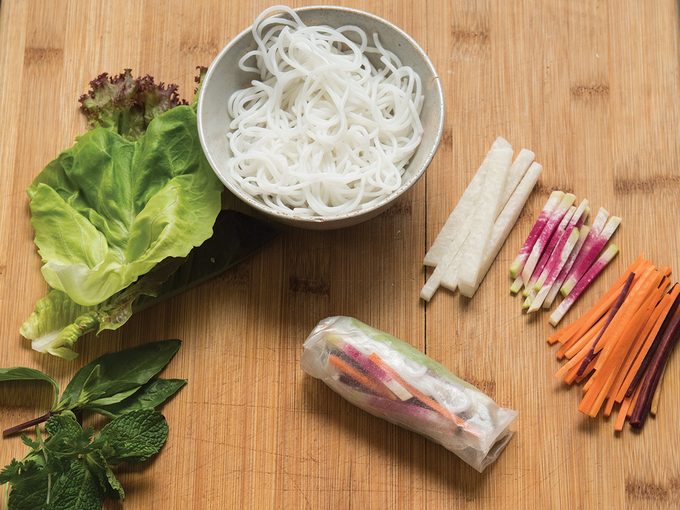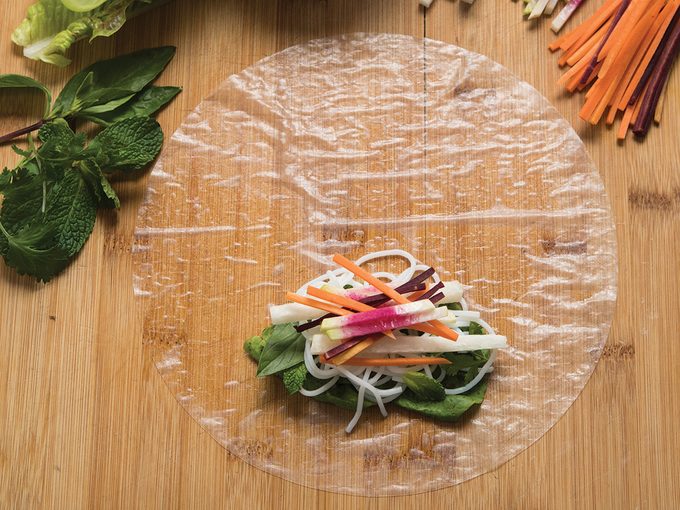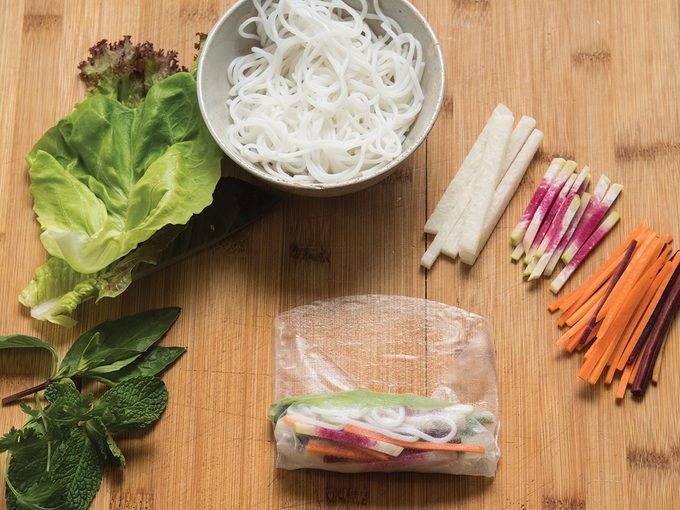Rice Paper Rolls: A Step-by-Step Guide to Preparing and Rolling
Use these helpful tips from Cameron Stauch’s Vegetarian Viêt Nam for making your very own rice paper rolls.

Here’s a list of helpful tips for preparing and rolling rice paper rolls
While some are specific to fresh summer rice paper rolls, you can apply many of the tips when you make deep-fried spring rolls. Don’t worry if the first few times you make the rolls your cuts aren’t the exact width or your rolls don’t look perfect. They’ll still taste fabulous. Once you’ve made either type of roll a few times you’ll easily get the hang of the process and can customize the fillings.
Click here for the full Rainbow Rolls recipe as pictured!
1. Cut ingredients, like tofu and vegetables, into thin strips of varying thicknesses and lengths
It facilitates rolling the rice paper and makes them easier to eat. Cut root vegetables like carrots and daikon radish into thin ⅛-inch thick (3 mm) matchsticks. I like to cut panfried tofu, raw jicama, and cucumber into strips ¼ inch (6 mm) thick, like shoestring French fries. For large (8½-inch; 22 cm) rice paper, cut ingredients into strips 3 to 4 inches (8 to 10 cm) long. For small (6-inch; 16 cm) rice paper, cut them into 2½-inch (6 cm) lengths. A Japanese mandoline or julienne vegetable peeler helps to quickly cut vegetables into matchsticks or slices of even thickness (see page 130).
2. Prepare all of the filling ingredients before you begin rolling
Wash and dry lettuce and herbs with a salad spinner. Cut ingredients into desired widths and lengths. Panfry or stir-fry any ingredients that need to be cooked.
3. Select soft, buttery large leaves from heads of lettuce such as Boston, Bibb, or butter leaf and tear them into palm-sized (3- to 4-inch; 8 to 10 cm) pieces
The leaves from stiffer lettuces like romaine can be used, but trim them from the firm ribs (save the ribs for a stir-fry or as a salad plate garnish) as they may pierce the delicate rice paper. The tiny shoots of chard, beet tops, or other lettuce leaves that make up the convenient grocery store mesclun mixes are fine to use, but trim off any tough stems.
4. Pick off the upper delicate stems of cilantro and other herb leaves from tough stems
Tear large Thai basil, mint, or Vietnamese balm leaves in half. Flavorful sprouts of broccoli, cress, mustard, or radish are tasty inclusions.
5. Resist the urge to mix all of the ingredients together before placing them on the rice paper
It quickens the assembly but doesn’t guarantee each bite is as flavorful as it can be with a little bit of everything in it. Sometimes I’ll mix together a couple of ingredients like matchsticks of carrots and daikon.
6. Divide some of the ingredients cut into strips—from matchsticks to ½-inch-thick (1.5 cm) strips—into small bundles
Then you can eyeball the portion of filling for each roll. It also helps prevent you from running out of some of the filling ingredients too early.
7. Organize all of your ingredients on a large plate or tray beside one another in the order that you’ll lay them down on the rice paper
I like to set up my tray in this order: lettuce, rice noodles, tofu, vegetable matchsticks or bean sprouts, broken rice crackers, and herbs.
8. Soften rice paper in warm to hot tap water for about 5 seconds
(It should be warm but cool enough to comfortably stick your fingers in it.) When the water cools, you have two options: heat the water on a burner until warm or discard the cold water and refill the frying pan or shallow container with warm tap water. Dip the entire rice paper in the hot water for 3 to 5 seconds. Any longer and it will become too soft and easily tear. The rice paper should remain slightly firm when removed from the water. As it rests on the cutting board, it continues to absorb moisture.

9. Layer and evenly spread out the ingredients
Lay the soft lettuce leaves and rice noodles down first, to act as a protective barrier, and to prevent any harder ingredients from piercing the rice paper. Evenly spread the ingredients the length you want the roll to be. Leave sides of the rice paper uncovered to facilitate the rice paper sticking to itself and to make the rolling easier.

10. Roll the rice paper rolls snugly
Use your index and middle fingers to guide and hold the filling in place. Rolled too loose, the filling will fall out. Rolled too tight and the rice paper may break.
11. An extra pair of hands is helpful when rolling a large number of rolls
Or better yet, prepare the filling ingredients in advance and have a party where you teach guests how to assemble and roll their own.
12. Serve rice paper rolls with a well-balanced flavourful dipping sauce
In most of the fillings there is little or no salt or seasoning. The sauce seasons the roll and brings all of the elements together in one bite. Serve the sauce in individualized condiment bowls or in a single bowl with a small spoon so that diners can drizzle some sauce into their rice paper roll.
13. Store the rolls in a single layer on a plate or tray
Cover with a lightly dampened clean dish towel and wrap in plastic, then leave in the fridge for up to several hours before serving. Cut large rice paper rolls in half or into thirds or use smaller rice paper for hors d’oeuvres.
Try this easy-to-make Vietnamese Pho.
Excerpted from Vegetarian Viêt Nam by Cameron Stauch. Copyright © 2018 by Cameron Stauch. Used with permission of the publisher, W.W. Norton & Company, Inc. All rights reserved.




